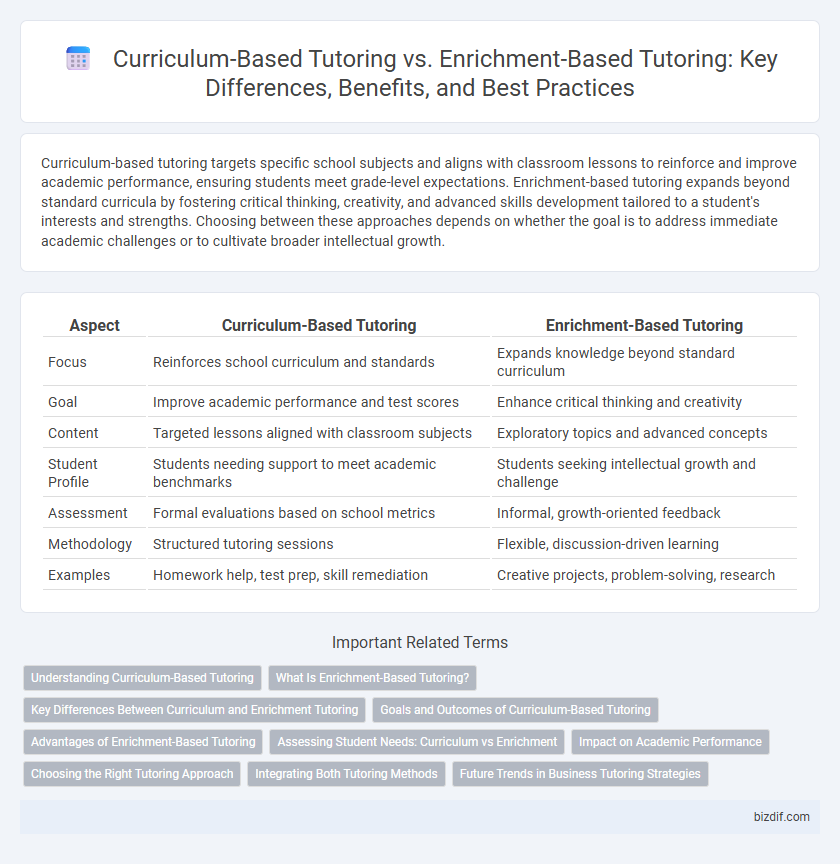Curriculum-based tutoring targets specific school subjects and aligns with classroom lessons to reinforce and improve academic performance, ensuring students meet grade-level expectations. Enrichment-based tutoring expands beyond standard curricula by fostering critical thinking, creativity, and advanced skills development tailored to a student's interests and strengths. Choosing between these approaches depends on whether the goal is to address immediate academic challenges or to cultivate broader intellectual growth.
Table of Comparison
| Aspect | Curriculum-Based Tutoring | Enrichment-Based Tutoring |
|---|---|---|
| Focus | Reinforces school curriculum and standards | Expands knowledge beyond standard curriculum |
| Goal | Improve academic performance and test scores | Enhance critical thinking and creativity |
| Content | Targeted lessons aligned with classroom subjects | Exploratory topics and advanced concepts |
| Student Profile | Students needing support to meet academic benchmarks | Students seeking intellectual growth and challenge |
| Assessment | Formal evaluations based on school metrics | Informal, growth-oriented feedback |
| Methodology | Structured tutoring sessions | Flexible, discussion-driven learning |
| Examples | Homework help, test prep, skill remediation | Creative projects, problem-solving, research |
Understanding Curriculum-Based Tutoring
Curriculum-based tutoring targets specific academic standards and aligns directly with classroom instruction, enhancing students' mastery of required content and skills. This approach uses school textbooks, teacher guidelines, and standardized testing frameworks to ensure consistent progress in core subjects. Personalized lesson plans emphasize filling knowledge gaps and reinforcing concepts critical for academic achievement and test performance.
What Is Enrichment-Based Tutoring?
Enrichment-based tutoring focuses on enhancing students' existing knowledge by exploring topics beyond the standard curriculum to stimulate critical thinking and creativity. It encourages intellectual curiosity through advanced concepts, real-world applications, and interdisciplinary learning opportunities. This type of tutoring supports gifted learners and those seeking academic challenges by fostering deeper understanding and skill development.
Key Differences Between Curriculum and Enrichment Tutoring
Curriculum-based tutoring strictly follows school syllabi, ensuring students master core subjects and meet academic standards through targeted practice and review. Enrichment-based tutoring extends beyond standard curricula, fostering critical thinking, creativity, and advanced skills through exploratory and interest-driven activities. The key difference lies in curriculum tutoring's focus on structured academic achievement versus enrichment tutoring's emphasis on holistic intellectual development and personalized learning experiences.
Goals and Outcomes of Curriculum-Based Tutoring
Curriculum-based tutoring targets mastery of specific academic standards and course content, ensuring students meet grade-level expectations and improve test scores. This approach emphasizes skill reinforcement and remediation aligned with school curricula, leading to measurable progress in core subjects such as math and reading. Outcomes include enhanced academic performance, increased confidence in standardized assessments, and preparation for classroom success.
Advantages of Enrichment-Based Tutoring
Enrichment-based tutoring enhances critical thinking, creativity, and a deeper understanding of subjects by exploring topics beyond the standard curriculum, fostering lifelong learning skills. It allows personalized learning experiences that adapt to a student's interests and strengths, promoting motivation and engagement. This approach develops problem-solving abilities and intellectual curiosity, preparing students for advanced academic challenges and real-world applications.
Assessing Student Needs: Curriculum vs Enrichment
Assessing student needs in curriculum-based tutoring focuses on identifying gaps in understanding specific academic standards and aligning lessons to school curricula, ensuring mastery of required content. In enrichment-based tutoring, evaluation centers on recognizing a student's interests, talents, and potential areas for intellectual growth beyond the standard curriculum to foster deeper engagement and creativity. Tailored assessments in each approach guide customized strategies that address either remediation for foundational skills or enhancement for advanced learning.
Impact on Academic Performance
Curriculum-based tutoring directly targets academic standards and specific classroom content, resulting in measurable improvements in test scores and subject mastery. Enrichment-based tutoring enhances critical thinking, creativity, and problem-solving skills, which can contribute to long-term academic success but often shows less immediate impact on standardized assessments. Combining both methods can optimize overall academic performance by addressing core competencies while fostering advanced cognitive abilities.
Choosing the Right Tutoring Approach
Selecting the appropriate tutoring approach depends on a student's specific needs and goals. Curriculum-based tutoring aligns closely with school standards, focusing on reinforcing classroom content to improve academic performance and standardized test results. Enrichment-based tutoring encourages curiosity and critical thinking through expanded topics beyond the curriculum, fostering deeper understanding and long-term intellectual growth.
Integrating Both Tutoring Methods
Integrating curriculum-based tutoring with enrichment-based tutoring creates a comprehensive educational approach that addresses both core academic skills and higher-order thinking abilities. This blended method enhances student engagement by aligning fundamental knowledge acquisition with opportunities for creative exploration and critical problem-solving. Research shows that combining these tutoring strategies leads to improved academic performance and deeper understanding across subjects.
Future Trends in Business Tutoring Strategies
Future trends in business tutoring strategies emphasize the integration of AI-driven personalization within both curriculum-based and enrichment-based tutoring models to enhance learner engagement and outcomes. Adaptive learning platforms that analyze real-time performance data enable tutors to customize content, addressing specific skill gaps while fostering critical thinking and creativity. The shift toward hybrid tutoring formats combines structured curriculum mastery with project-based enrichment, meeting diverse business training demands and accelerating professional development.
Curriculum-Based Tutoring vs Enrichment-Based Tutoring Infographic

 bizdif.com
bizdif.com